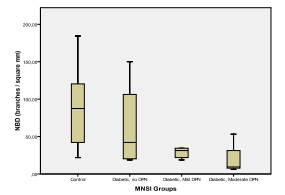
Featured in:
The International Conference on Health Informatics, Vilamoura, Portugal
Authors:
Susana Silva, Iulian Otel, Sofia Gouveia, Leonor Gomes, Luís Negrão, Maria João Quadrado, Nuno Gonçalves, João Barreto and António Miguel Morgado.
Diabetic peripheral neuropathy (DPN) is one of the more common complications of diabetes, being associated to 50-75% of non-traumatic amputations. Early diagnosis of DPN often fails or occurs only when patients became symptomatic due to the non-availability of a simple, reliable, noninvasive method.We present the results of a pilot study where we used peripheral nerves morphometric information, retrieved from images of the corneal sub-basal nerve plexus, obtained in vivo by corneal confocal microscopy, to identify and stage patients with DPN. Nerve segmentation was done manually and using an automatic algorithm. Both standard statistical techniques and classification techniques were used for DPN identification.With manual segmentation, differences were found between controls and patients with mild and moderate DPN, for the nerve fiber length and density parameters. A simple comparison between individuals with and without DPN results in significant differences for those parameters, as well as for branching pattern and density. No differences were found with automatic segmentation. Simple classification techniques based on manually extracted parameters were tested for identification of DPN patients. The best results were obtained with a binary tree classifier, using PCA transformed data, for a pruning level 9. The classifier accuracy was 87%.The results confirm that morphometric analysis of corneal nerves images may be used as a complementing technique for DPN diagnosis. A fully automatic tool for identifying and staging DPN patients requires additional work on the nerve segmentation algorithm and the use of more robust classifiers with additional reliance on image features other than the tested morphometric parameters.
© 2024 VISTeam | Made by Black Monster Media

Institute of Systems and Robotics Department of Electrical and Computers Engineering University of Coimbra